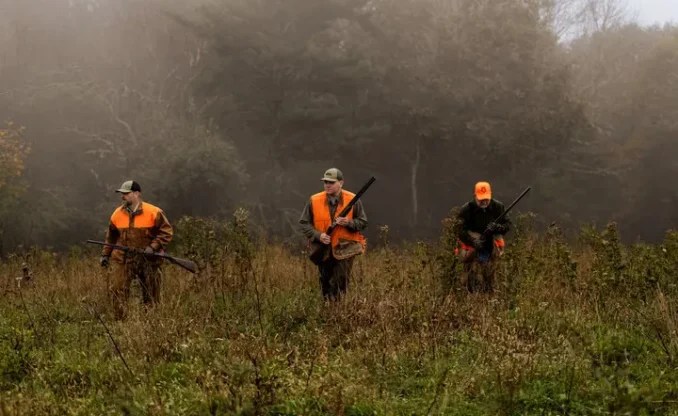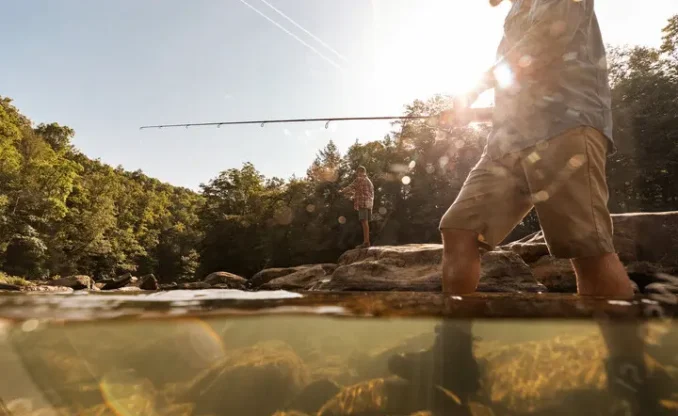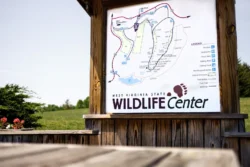Native Species of West Virginia
West Virginia is home to an abundance of native species, big and small. While most of these pose no threat to humans, it is always best to keep your distance and not disturb wildlife. Remember to take only photographs and leave only footprints when in their home!
Mammals
West Virginia is home to at least 70 different wild mammals. Four of West Virginia’s mammals—the Virginia big-eared bat, Indiana bat, West Virginia northern flying squirrel and extirpated eastern cougar—are federally listed as endangered. Several additional species are rare in West Virginia and warrant close monitoring.
Three species of mammals no longer exist in West Virginia: the bison, elk and gray wolf. The last recorded bison in West Virginia was killed near Valley Head, Randolph County in 1825. Elk were reported near the headwaters of the Tygart and Greenbrier rivers as late as 1875 but were gone by 1890. Bounties were paid on wolves in West Virginia through the late 1800s with the last recorded wolf killed in 1900.
The beaver, fisher and river otter were also eradicated, but were reintroduced in the 1930s, 1969 and 1985, respectively. Wild boar were introduced into the state in 1971. Today a population of wild boar exists in Boone, Logan, Raleigh and Wyoming counties.
The black rat (roof rat), Norway rat and house mouse all came to the continental United States with settlers and traders. Dogs, cats and goats that have wandered off or were abandoned have established or feral populations in portions of the state.
Just as human activities have resulted in the decline and extinction of some mammals, these activities also have resulted in increased abundance and range expansion of others. The opossum is more abundant and more widely distributed due to human activities, as are mammals that prefer farm and early successional habitats. The coyote is expanding its range eastward and now occurs throughout the Mountain State.
Helpful Resources
Fish
Whether you’re seeking secluded wilderness trout fishing or a family vacation, a quality angling experience awaits you in the Mountain State. More than 20,000 miles of streams and over 100 public fishing lakes provide anglers of all ages with a wide variety of prospects. Year-round fishing, including an open-season for trout, is available. West Virginia offers catch and-release and fly-fishing-only streams to challenge the enthusiast, as well as shoreline fishing, boat launching, and facilities for the physically challenged throughout the state. All children under 15 fish for FREE.
Fish for native brook trout in headwater streams in Monongahela National Forest or cast for rainbow trout in one of more than 120 stocked trout streams. Small public fishing lakes are stocked beginning in January and stocking of catchable rainbows, browns, brook and West Virginia golden rainbows continues through May in suitable waters.
Prized for their fighting ability, smallmouth bass are one of the most popular game fish in West Virginia. Put your angling skills to the test with a float trip on one of the oldest rivers in the world, the New River. If you’re looking for something a little more tame, relax lakeside at Summersville Lake.
Increase your odds with the fish of 10,000 casts. Longstanding management and stocking efforts have established outstanding stream musky fishing. Trophy muskies over 40 inches are not uncommon from native and stocked waters.
Trout: Cranberry River, Dogway Fork, Otter Creek, Blackwater River, Elk River, Back Fork of Elk River, Shavers Fork of Cheat River, Slatyfork section of Elk River, Williams River, North Fork of the South Branch of the Potomac River
Smallmouth Bass Greenbrier River, New River, South Branch of the Potomac River, Gauley River
Largemouth Bass: Stonewall Jackson Lake, Sleepy Creek Lake, O’Brien Lake, Woodrum Lake, Upper Mud Lake, Cheat Lake, Ohio River, Elk Fork Walleye Kanawha River, Ohio River, New River, Gauley River, Tygart Lake, Summersville Lake
Channel Catfish: Stonewall Jackson Lake, Bluestone Lake, East Lynn Lake, Kanawha River, Ohio River Musky Middle Island Creek, Buckhannon River, Mud River, Hughes River, Little Kanawha River, New River, Kanawha River, Gauley River, Stonewall Jackson Lake, Burnsville Lake, Stonecoal Lake
For more information on fishing these waters and others, please visit www.wvdnr.gov and check the state fishing regulations. West Virginia State Parks, Forests and Wildlife Management Areas Many state parks, forests and WMAs are located on lakes, rivers and streams. With a wide variety of accommodations to choose from, West Virginia offers excellent fishing opportunities for the whole family to enjoy. Please call 1-800-CALL WVA or visit www.wvdnr.gov for more information.
- Babcock State Park – Trout, Smallmouth Bass Beech Fork State Park/WMA – Largemouth Bass, Hybrid Striped Bass
- Blackwater Falls State Park – trout Bluestone State Park/WMA – Smallmouth Bass, Hybrid Striped Bass, Channel Catfish, Flathead Catfish
- Hawks Nest State Park – Smallmouth Bass, Channel Catfish
- Greenbrier River Trail – Smallmouth Bass
- Greenbrier State Forest – Smallmouth Bass
- Kanawha Falls WMA – Smallmouth Bass, Walleye, Musky, Hybrid Striped Bass
- Kumbrabow State Forest – Trout
- Moncove Lake State Park/WMA – Largemouth Bass, Channel Catfish
- North Bend State Park – Largemouth Bass, Musky
- Pipestem Resort State Park – Largemouth Bass, Smallmouth Bass, Trout
- Seneca State Forest – Smallmouth Bass, Trout
- Stonewall Jackson Lake Resort State Park/WMA – Largemouth Bass, Channel Catfish, Musky, Crappie, Tailwater Trout
- Tygart Lake State Park/WMA – Largemouth Bass, Walleye
- Watoga State Park – Smallmouth Bass, Trout
Helpful Resources
Fish of West Virginia Checklist
Anglers Alert
Anglers are reminded that West Virginia law prohibits the release of fish or other aquatic organisms into public waters, unless a stocking permit is issued by the Director of the Division of Natural Resources. Stocking permits are not required for trout and black bass stocking provided that disease-free certifications are obtained prior to stocking, or if trout originate from a source within the state. A permit is not required for stocking native or established fish into privately owned ponds.
Moving live fish or other aquatic animals and plants from one body of water to another can cause long-term damage to the ecological stability of lakes and streams and can threaten recreational fishing. Please take these precautions to prevent problems.
Please:
- Do not move fish from one body of water to another
- Drain live wells thoroughly before leaving an access area
- Do not release live baitfish or aquarium fish into West Virginia’s waters
- Remove all visible plants and animals from your boat, motor, trailer and nets before leaving an access area
For more information on aquatic nuisance species please visit Protect Your Waters.
Birds
West Virginia, with its temperate climate, diverse vegetation and dramatic topography, plays host to numerous species of birds throughout the year. In fact, there are 300 plus species of birds that inhabit the state during some portion of the year. More than 75 of these species are known to breed in the state, with the remainder being migrants that pass through or species that spend the winter here.
Watch eagles soar over the Potomac River, listen to the songs of warblers courting in dense evergreen forests atop the Allegheny Plateau, see woodpeckers scour the bark of oak trees for insects, wade through a high elevation fen to glimpse a bittern, or watch waterfowl resting on a migration stopover along the Ohio River. These and many other natural wonders await even the casual bird watcher in West Virginia.
Late spring through early fall is when avian diversity is highest in the Mountain State. From April to July you can rise early and hear the songs of the various species that breed here. Fall and spring are good times to see birds migrating over major waterways and along mountain ridges. Even winter affords the bird watcher access to over 50 species that brave West Virginia’s rugged weather.
Helpful Resources
Birds of West Virginia Checklist
Reptiles and Amphibians
West Virginia is home to a variety of reptile and amphibian species. From the eastern hellbender to the spotted turtle, we are a state rich in herpetological diversity. To find out more about each individual species and current herpetological research, visit Marshall University’s Herpetology Lab (www.marshall.edu/herp) webpage.
WVDNR funded projects and herpetological research:
With 35 salamander species, 14 frog and toad species, 13 turtle species, 6 lizard and skink species, and 20 species of snakes there is much to learn and study here in West Virginia. Many past and current reptile and amphibian projects have been funded by the DNR. Most studies have been conducted by Dr. Tom Pauley of Marshall University. His 30-plus years of research has provided the DNR with most of what we know about reptiles and amphibians in West Virginia.
Species of Concern:
Several amphibian and reptile species are on our rare species list. There are many reasons why a species may be considered rare in West Virginia. Some species such as the White-spotted salamander are rare because they have extremely narrow range. This particular species only occurs in a small area on the West Virginia/ Virginia border.
Other species are considered rare because of recent declines due to habitat destruction, decreased water quality, or other human interferences. For example, many people are unaware that the Timber rattlesnake is a species in decline. Senseless killing and habitat loss are the chief reasons for the decreased numbers of this species. For other species, West Virginia is at the edge of their ranges or we do not have suitable habitat. Populations may be stable elsewhere but they are rare here. These species are of special concern because if population declines are occurring, they are usually noted at the species periphery. The Six-lined racerunner, a lizard, has only been found in one location in West Virginia. It is a common species to the south and west of West Virginia.



